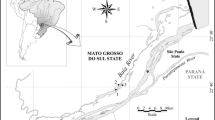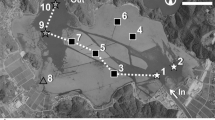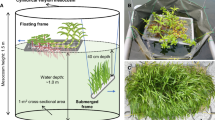Abstract
Many aquatic systems worldwide have experienced significant changes in littoral macrophyte communities from altered hydrology in the form of water controls structures (e.g., dams). Water level stabilization for flood control can cause persistent occurrence of dense stands of emergent macrophytes, which can affect the physicochemical environment for fishes. We evaluated dissolved oxygen (DO) concentrations in five emergent macrophyte species (cattail Typha spp., pickerelweed Pontedaria cordata, smartweed Polygonum spp., torpedograss Panicum repens, and water primrose Ludwigia spp.) at three levels of macrophyte coverage (i.e., 50–64, 65–79, and 80–95%) at Lake Istokpoga, Florida during July–August (summer) and October–November (fall) 2007. Dissolved oxygen exhibited substantial spatial and temporal variability at small scales (i.e., meters and hours), with the lowest DO and highest probability of hypoxia occurring in smartweed and water primrose habitats relative to other macrophyte types. The probability of hypoxia increased with macrophyte coverage for all macrophyte species tested. Dissolved oxygen was influenced by the structural differences (e.g., stem density and size) and spatial orientation (e.g., proximity to open water) associated with the individual macrophyte habitats. Restoration efforts that create open water pathways and maximize edge areas might improve DO concentrations and habitat quality and quantity for freshwater fishes.





Similar content being viewed by others
References
Akaike H (1974) A new look at the statistical model identification. IEEE Transactions on Automatic Control 19:716–723
Allen MS, Tugend K (2002) Effects of a large-scale habitat enhancement project on habitat quality for age-0 largemouth bass at Lake Kissimmee, Florida. In: Phillip DP, Ridgeway MS (eds) Black Bass: ecology, conservation, and management. American Fisheries Society, Maryland, pp 265–276
Azza N, Denny P, Van De Koppel J, Kansiime F (2006) Floating mats: their occurrence and influence on shoreline distribution of emergent vegetation. Freshwater Biology 51:1286–1297
Boettcher EJ, Fineberg J, Lathrop D (2000) Turbulence and wave breaking effects on air-water gas exchange. Physical Review Letters 85:2030–2033
Breitberg DL, Loher T, Pacey CA, Gernstein A (1997) Varying effects of low dissolved oxygen on trophic interactions in an estuarine food web. Ecological Monographs 67:489–507
Brenner M, Binford M, Deevey E (1990) Lakes. In: Myers RL, Ewel JJ (eds) Ecosystems of Florida. University of Central Florida Press, Florida, pp 364–390
Bunch AJ (2008) Fish community composition and dissolved oxygen dynamics in dense emergent macrophyte stands at Lakes Istokpoga and Kissimmee, Florida. Thesis. University of Florida
Burleson ML, Wilheim D, Smatresk N (2001) The influence of fish size on the avoidance of hypoxia and oxygen selection by largemouth bass. Journal of Fish Biology 59:1336–1349
Caraco N, Cole J, Findlay S, Wigand C (2006) Vascular plants as engineers of oxygen in aquatic systems. BioScience 56:219–225
Diaz RJ (2001) Overview of hypoxia around the world. Journal of Environmental Quality 30:275–281
Eby LA, Crowder L, McClellan C, Peterson C, Powers J (2005) Habitat degradation of intermittent hypoxia: impacts on demersal fishes. Marine Ecological Progress Series 291:249–261
Fernandez C, Fernandez M, Becares E (1999) Influence of water-level fluctuation on the structure and composition of the macrophyte vegetation in two small temperate lakes in Northwest Spain. Hydrobiologia 415:155–162
Ferreira LV, Stohlgren TJ (1999) Effects of river level fluctuation on plant species richness, diversity, and distribution in a floodplain forest in Central Amazonia. Oecologia 120:582–587
Florida LAKEWATCH (2005) Data report. School of Forest Resources and Conservation, University of Florida. Available via http://lakewatch.ifas.ufl.edu/data2005.htm. Accessed 5 May 2008
Goodrick RL, Milleson J (1974) Studies of floodplain vegetation and water-level fluctuation in the Kissimmee River Valley. Technical Report 74-2. South Florida Water Management District, Central and Southern Florida Flood Control District, West Palm Beach, Florida
Graham JB (1997) Air-breathing fishes: evolution, diversity, and adaptation. Academic, San Diego
Hamilton SK, Sippel S, Melack J (1995) Oxygen depletion and carbon dioxide and methane production in waters of the Pantanal wetland of Brazil. Biogeochemistry 30:115–141
Hudon C (1997) Impact of water-level fluctuation on St. Lawrence River aquatic vegetation. Canadian Journal of Fisheries and Aquatic Sciences 54:2853–2865
Keddy PA, Fraser L (2000) Four general principles for the management and conservation of wetlands in large lakes: the role of water levels, nutrients, competitive hierarchies and centrifugal organization. Lakes and Reservoirs: Research and Management 5:177–185
Keddy PA, Reznicek A (1986) Great Lakes vegetation dynamics: the role of fluctuating water levels and buried seeds. Journal of Great Lakes Research 12:25–36
Killgore KJ, Hoover J (2001) Effects of hypoxia on fish assemblages in a vegetated waterbody. Journal of Aquatic Plant Management 39:40–44
Kramer DL (1987) Dissolved oxygen and fish behavior. Environmental Biology of Fishes 18:81–92
Lassen C, Revsbech N, Pedersen O (1997) Macrophyte development resuspension regulate the photosynthesis and production of benthic microalgae. Hydrobiologia 350:1–11
Lewis WM Jr (1970) Morphological adaptations of cyprinodontoids for inhabiting oxygen deficient waters. Copeia 1970:319–326
Leyer I (2005) Predicting plant species’ responses to river regulation: the role of water level fluctuations. Journal of Applied Ecology 42:239–250
Lightbody AF, Nepf H (2006) Prediction of near-field shear dispersion in an emergent canopy with heterogeneous morphology. Environmental Fluid Mechanics 6:477–488
Miranda LE, Driscoll M, Allen M (2000) Transient physiochemical microhabitats facilitate fish survival in inhospitable aquatic plant stands. Freshwater Biology 44:617–628
Moss DD, Scott D (1961) Dissolved-oxygen requirements of three species of fish. Transactions of the American Fisheries Society 90:377–393
Nepf HM (1999) Drag, turbulence, and diffusion in flow through emergent vegetation. Water Resources Research 35:479–489
Riis T, Hawes I (2002) Relationships between water-level fluctuation and vegetation diversity in shallow water of New Zealand lakes. Aquatic Botany 74:133–148
Rose C, Crumpton W (2006) Spatial patterns in dissolved oxygen and methane concentrations in prairie pothole wetlands in Iowa, USA. Wetlands 26:1020–1025
Smale MA, Rathbuni C (1995) Hypoxia and hyperthermia of headwater stream fishes. Transactions of the American Fisheries Society 124:698–710
Smith DH, Smart R, Hanlon C (2004) Influence of water level on torpedograss establishment in Lake Okeechobee, Florida. Lake and Reservoir Management 20:1–13
Steinman AD, Rosen B (2000) Lotic-lentic linkages associated with Lake Okeechobee, Florida. Journal of the North American Benthological Society 19:733–741
Toth LA, Melvin S, Arrington D (1998) Hydrologic manipulations of the channalized Kissimmee River. BioScience 48:757–764
Toth LA, Koebel J Jr, Warne A, Chamberlain J (2002) Implications of reestablishing prolonged flood pulse characteristics of the Kissimmee River and floodplain ecosystem. In: Middleton BA (ed) Flood pulsing in wetlands: restoring the natural hydrological balance. Wiley, New York, pp 191–221
Webster JR, Benfield E (1986) Vascular plant breakdown in freshwater ecosystems. Annual Review of Ecology and Systematics 17:567–594
Wu RS (2002) Hypoxia: from molecular responses to ecosystem responses. Marine Pollution Bulletin 45:35–45
Acknowledgments
The Florida Fish and Wildlife Conservation Commission provided funding for this research. Tim Bonvechio, Tim Coughlin, Larry Davis, Beacham Furse, Steve Gornak, and Craig Mallison provided critical insight on fish and macrophyte communities. Special thanks to Drew Dutterer, Patrick O’Rouke, Erika Thompson, and Allison Watts for help in the field. Matt Catalano and Mark Rogers provided help with analyses. Mike Netherland, Karl Havens, and anonymous reviewers provided useful editorial comments.
Author information
Authors and Affiliations
Corresponding author
Rights and permissions
About this article
Cite this article
Bunch, A.J., Allen, M.S. & Gwinn, D.C. Spatial and Temporal Hypoxia Dynamics in Dense Emergent Macrophytes in a Florida Lake. Wetlands 30, 429–435 (2010). https://doi.org/10.1007/s13157-010-0051-9
Received:
Accepted:
Published:
Issue Date:
DOI: https://doi.org/10.1007/s13157-010-0051-9




